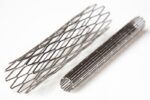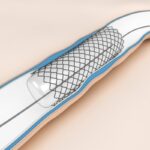Summary: Second-generation drug-eluting stents have shown better results than their predecessors. In this study we compare two second-generation drug stents in patients with unprotected left coronary trunk injuries. Methods and results: 650 patients with unprotected trunk injury were randomized to either XIENCE V (everolimus eluting) or RESOLUTE (zotarolimus eluting) stents. The primary endpoint was the<a href="https://solaci.org/en/2015/06/24/isar-left-main-2-everolimus-eluting-stents-versus-zotarolimus-eluting-stents-in-the-treatment-of-the-unprotected-left-coronary-trunk/" title="Read more" >...</a>
DKCRUSH-III: Crushing versus Culotte technique for left main coronary artery
Angioplasty of the unprotected distal left main coronary artery with 2 stents presents the less favorable results in the segment. The double kissing (DK) technique and Culotte technique have been reported as effective for the treatment of bifurcation lesions, however this has never been tested for left main coronary artery. The DKCRUSH-III study investigated the<a href="https://solaci.org/en/2015/06/24/dkcrush-iii-crushing-versus-culotte-technique-for-left-main-coronary-artery/" title="Read more" >...</a>
RENAL DES: reduction of restenosis in patients with kidney failure
Coronary angioplasty in patients with kidney failure is associated with an increased occurrence of events. This study compared the efficacy of preventing clinical restenosis using an everolimus-eluting stent versus a conventional stent, both implanted in the same patient with lesions in more than one vessel and suffering from kidney failure. The primary endpoint was target<a href="https://solaci.org/en/2015/06/24/renal-des-reduction-of-restenosis-in-patients-with-kidney-failure/" title="Read more" >...</a>
ADVISE II: functional assessment of coronary lesions without adenosine
The pressure ratio in the resting phase of the cardiac cycle is a newly Introduced procedure for the assessment of coronary stenoses based on pressure measurement without adenosine. It generated interest with over 1500 comparisons with the FFR since its introduction at TCT 2011. The discrepancies between the two methods have been attributed to the<a href="https://solaci.org/en/2015/06/24/advise-ii-functional-assessment-of-coronary-lesions-without-adenosine/" title="Read more" >...</a>
Clinical presentation of restenosis in the three generations of DES
Original title: Clinical Presentation and Outcomes of Coronary In-Stent Restenosis Across 3-Stent Generations. Reference: Marco A. Magalhaes et al. Circ Cardiovasc Interv. 2014;7:00-00. Studies evaluating the clinical presentation of restenosis after implantation of bare metal stent showed that the recurrence of stenosis is not a benign complication as previously thought, with a significant number of patients with restenosis<a href="https://solaci.org/en/2015/04/28/clinical-presentation-of-restenosis-in-the-three-generations-of-des/" title="Read more" >...</a>
Worse post TAVI ejection fraction recovery in coronary artery disease patients without revascularization
Original title: Impact of coronary artery disease on left ventricular ejection fraction recovery following transcatheter aortic valve implantation. Reference: Freixa X et al. Catheter Cardiovasc Interv. 2014;Epub ahead of print. This single center study analyzed data form 56 consecutive patients with severe aortic stenosis and LVEF of ≤ 50% undergoing TAVI (transcatheter aortic valve implantation) between March 2006<a href="https://solaci.org/en/2014/10/06/worse-post-tavi-ejection-fraction-recovery-in-coronary-artery-disease-patients-without-revascularization/" title="Read more" >...</a>
Severe coronary calcification is a predictor of coronary events in acute coronary syndromes
Original title: Ischemic Outcomes After Coronary Intervention of Calcified Vessels in Acute Coronary Syndromes. Pooled Analysis From the HORIZONS and ACUITY Trials. Reference: Philippe Généreux, et al. J Am Coll Cardiol 2014;63:1845-54 Calcification of the arteries has always been a challenge and a generator of problems during coronary angioplasty, but its impact on acute coronary syndromes has not<a href="https://solaci.org/en/2014/05/21/severe-coronary-calcification-is-a-predictor-of-coronary-events-in-acute-coronary-syndromes/" title="Read more" >...</a>
Usefulness of FFR in coronary bypass intermediate lesions
Original title: Long-term clinical outcome after fractional flow reserve– versus angio-guided percutaneous coronary intervention in patients with intermediate stenosis of coronary artery bypass grafts. Reference: Luigi Di Serafino et al. Am Heart J 2013;166:110-8. Bypass coronary angioplasty is often preferred strategy versus re-operation , however it is associated with a greater number of events, both short and long<a href="https://solaci.org/en/2013/09/24/usefulness-of-ffr-in-coronary-bypass-intermediate-lesions/" title="Read more" >...</a>
2nd generation drug-eluting stents intended for left main coronary artery
Original title: Zotarolimus- versus Everolimus-Eluting Stents for Unprotected Left Main Coronary Artery Disease. ISAR-LEFT MAIN 2 Study. Reference: Julinda Mehilli et al. J Am Coll Cardiol, article in press. Improvements in 2nd generation drug-eluting stents led to increased efficiency and safety , however there is little information on these new platforms to treat left main coronary artery .<a href="https://solaci.org/en/2013/08/29/2nd-generation-drug-eluting-stents-intended-for-left-main-coronary-artery/" title="Read more" >...</a>
Zotarolimus-eluting stent in-stent restenosis
Original title: Clinical Outcomes of the Resolute Zotarolimus-Eluting Stent in Patients With In-Stent Restenosis Two-Year Results From a Pooled Analysis. Reference: Gert Richardt et al. J Am Coll Cardiol Intv 2013, article in press. Previous studies reported a target lesion revascularization (TLR) of 15% and target vessel (TVR) of 22% after a year of treating an injury-stent restenosis.<a href="https://solaci.org/en/2013/08/16/zotarolimus-eluting-stent-in-stent-restenosis/" title="Read more" >...</a>







